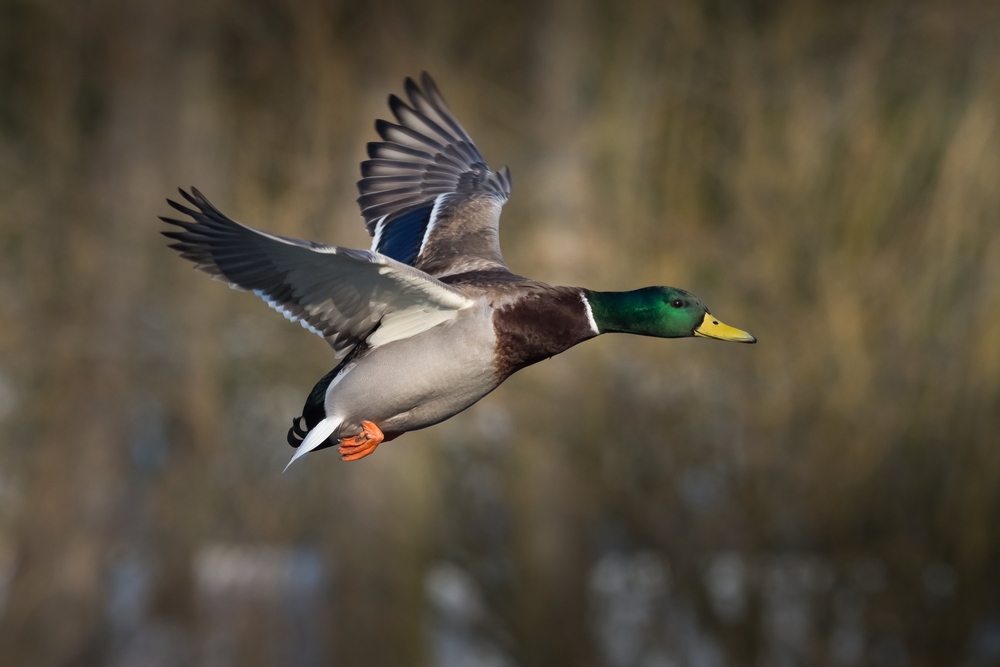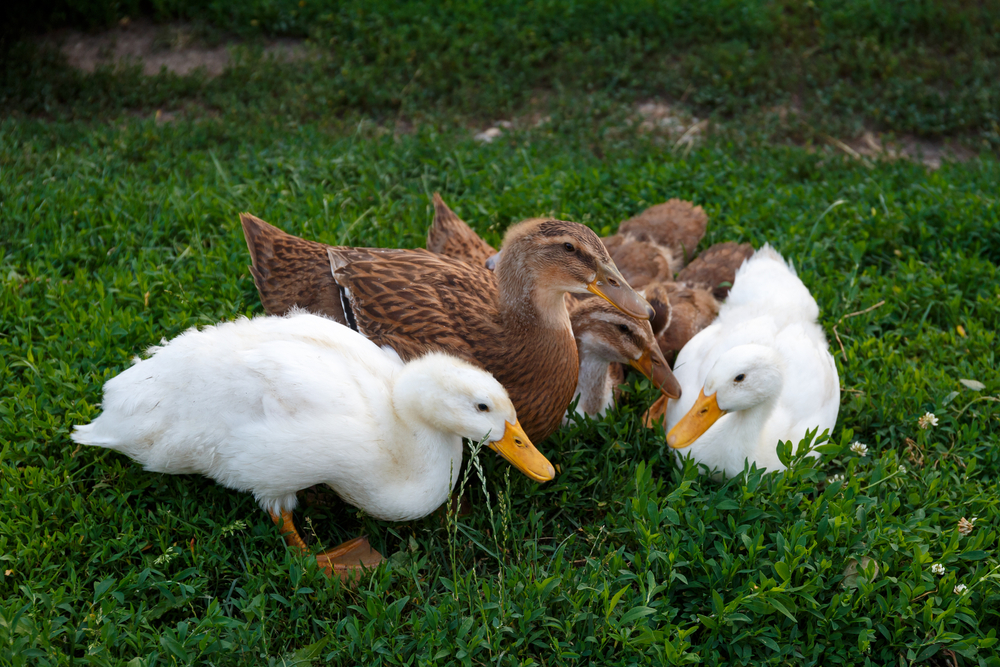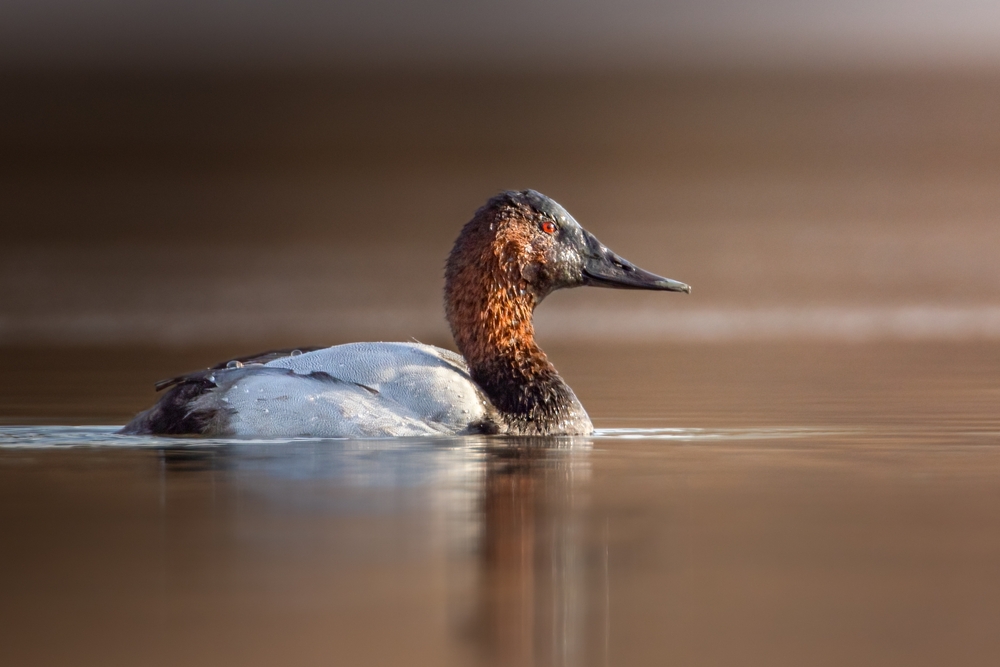The Mexican Duck (Anas diazi) is its closest relative (formerly treated as a Mallard subspecies). Very close, too, are the American Black Duck and Mottled Duck.
About
The Mallard (Anas platyrhynchos) is one of the most widespread and recognizable ducks in the world, belonging to the family Anatidae. Native to North America, Europe, Asia, and parts of North Africa, it has also been introduced to Australia and New Zealand, making it a truly global species. Highly adaptable, Mallards thrive in wetlands, rivers, lakes, ponds, marshes, and even urban parks, where they are often seen swimming or dabbling for food.
Adult males, known as drakes, are especially striking in breeding plumage, with glossy green heads, white neck rings, chestnut-brown breasts, gray bodies, and curled black tail feathers. Females, by contrast, are mottled brown with orange-and-black bills, providing excellent camouflage while nesting. Both sexes show a distinctive blue wing patch, called a speculum, bordered by white, which is visible in flight. Mallards are medium-sized ducks, typically 50–65 cm (20–26 in) long with a wingspan of 81–98 cm (32–39 in).
Mallards are omnivorous dabblers, feeding mainly on aquatic vegetation, seeds, grains, insects, and small invertebrates. They forage by tipping forward in shallow water rather than diving. Their adaptability in diet has helped them flourish in both wild and urban environments.
Breeding occurs in spring and summer. Pairs form during winter and early spring, with males courting females through elaborate displays. Nests are built on the ground, often hidden in vegetation near water. The female lays 8–13 eggs and incubates them alone for about 28 days. Ducklings are precocial, leaving the nest within a day of hatching and following their mother to water, where they feed themselves while she protects them.
The Mallard is the ancestor of most domestic duck breeds and plays a vital ecological role as both prey and seed disperser. While generally abundant, hybridization with domestic ducks and habitat loss pose challenges in some areas.
Physical Characteristics
The Mallard (Anas platyrhynchos) is a medium-sized dabbling duck with bold sexual dimorphism and classic waterfowl proportions.
Head & Bill
Males (drakes) show an iridescent green head with a narrow white neck ring and yellow bill. Females (hens) are mottled brown with an orange bill marked in black. Both have dark eyes and a smooth, gently sloped forehead-to-bill profile.
Plumage
Drakes: chestnut breast, pale gray flanks and body, black rump, and glossy black tail-center with white borders. Hens: intricately mottled tan-brown for camouflage. Both sexes display a violet-blue wing speculum bordered by white bars. Drakes assume a brownish eclipse plumage after breeding.
Body
Streamlined, buoyant body with dense, waterproof contour feathers and abundant down for insulation. Compact chest and full flanks suited to surface foraging.
Wings
Long, pointed wings enable fast, direct flight. The shimmering speculum on the secondaries is prominent in flight and at rest.
Tail
Short and slightly upturned. Males typically show upcurled central “drake feathers.”
Legs & Feet
Orange legs placed slightly rearward for efficient paddling; large, webbed feet provide propulsion on water and stability on soft substrates.
Size
-
Length: 20–26 in (50–65 cm)
-
Wingspan: 32–39 in (81–99 cm)
-
Weight:
-
Adult Male: ~2.4–3.0 lbs (1.1–1.4 kg)
-
Adult Female: ~2.1–2.7 lbs (0.95–1.2 kg)
-
Mallards’ broad, lamellate bills for filtering, waterproof plumage, and webbed feet reflect adaptations for dabbling—feeding at the surface or by tipping up rather than deep diving.
Reproduction
The Mallard (Anas platyrhynchos) follows the classic dabbling-duck pattern: seasonal pair bonds, ground nests lined with down, a single annual brood (with re-nesting if needed), and precocial young.
Mating and Courtship
Courtship begins in late winter on rivers, ponds, and marshes. Drakes perform head-bobs, grunt-whistles, and splash displays in small courting groups. Pair bonds are seasonal; males accompany females through egg-laying but rarely assist with incubation.
Breeding Season
Nesting generally runs from April to July in temperate zones, earlier in mild climates and later at higher latitudes/elevations.
Nesting
The female selects a concealed ground site—dense grasses, shrubs, crop stubble, or tussocks—sometimes surprisingly far from water. She builds a shallow cup of vegetation and lines it with her own down as laying progresses.
Eggs
Typical clutch 8–13 pale green to buff eggs (occasionally fewer in first nests, more in dump-nests). Eggs average about 2.2–2.5 in (5.6–6.4 cm) long.
Incubation
Female-only incubation lasts 26–29 days. Once incubation begins, the drake usually departs to molt into eclipse plumage nearby.
Chick Development
Ducklings hatch precocial—downy, eyes open, mobile within hours. The hen leads them to water the day of or after hatching. Young feed themselves on small invertebrates and plant matter while the hen provides protection and thermoregulation.
Fledging and Independence
Flight feathers develop by 45–60 days (lighter, early-hatched broods fledge sooner in good habitat). Families then disperse as juveniles gain full flight and independence.
Broods per Year & Re-nesting
Normally one brood annually. If a clutch is lost early, hens commonly re-nest (sometimes multiple attempts). Successful second broods are uncommon at northern latitudes.
Special Notes
Mallards frequently engage in intra- and interspecific brood parasitism (“dump-nesting”), adding eggs to neighbors’ nests. Most individuals breed in their first year.
Lifespan
The Mallard (Anas platyrhynchos) combines high reproduction with high juvenile mortality; those that reach adulthood can live several years, with rare long-lived outliers.
Lifespan in the Wild
Typical survivors live 3–7 years. Many ducklings die in the first year from predation and weather. Banding records show exceptional individuals reaching 20+ years.
Lifespan in Captivity
With steady diet, predator protection, and veterinary care, mallards commonly reach 10–15 years, occasionally longer.
Key Mortality Drivers
-
Predation: Eggs/ducklings—foxes, raccoons, gulls, corvids; adults—raptors and mammalian predators.
-
Habitat loss & disturbance: Drained wetlands, shoreline development, and human disturbance reduce nest success.
-
Hunting & lead exposure: Legal harvest and legacy lead shot/tackle (where still present) increase mortality.
-
Disease & toxins: Avian influenza, botulism, parasites; poor-quality or moldy grain can be lethal.
-
Weather extremes: Late cold snaps, drought, and storms lower survival and recruitment.
Conserving diverse wetlands, reducing disturbance during nesting, eliminating lead sources, and maintaining clean foraging areas help mallards achieve their upper lifespan potential.
Eating Habits
The Mallard (Anas platyrhynchos) is a highly adaptable omnivorous dabbler, switching foods with season and habitat.
Diet
Seeds and grains (smartweed, millet, corn, rice), aquatic plants (pondweeds, wild celery leaves, duckweed), and invertebrates—midges, beetles, snails, amphipods, small crustaceans. During breeding, protein-rich invertebrates increase; in winter, more seeds and tubers.
Foraging Strategy
Primarily surface feeding and tip-up dabbling in shallow water to reach submerged leaves and seeds. Also grazes on land in fields and lawns, and will glean along shorelines and mudflats.
Feeding Mechanics
Broad, lamellate bill filters food from water and soft sediments. The tongue pumps water through fine comb-like edges; edible particles are trapped and swallowed.
Daily Rhythm
Most active at dawn and dusk; night feeding is common on quiet waters and agricultural fields. Midday often spent loafing, preening, and digesting.
Seasonal Shifts
-
Spring: carbohydrate-rich seeds/tubers to fuel migration; increasing insects before breeding.
-
Breeding: higher proportion of aquatic invertebrates for egg formation and duckling growth.
-
Fall/Winter: seeds, grains, and vegetative matter dominate, with opportunistic invertebrates during warm spells.
Social Feeding
Often forages in flocks, especially outside the breeding season, sometimes mixed with other dabbling ducks. Individuals watch conspecifics to locate productive patches.
Habitat & Depth
Prefers shallow wetlands—marsh edges, beaver ponds, flooded fields, estuarine shallows—generally feeding in water <20 in (50 cm) deep where tip-ups suffice.
Human Foods (Notes)
Mallards readily accept handouts, but bread and junk foods are harmful (malnutrition, angel wing). Provide native seeds, cut greens, or waterfowl pellets where feeding is allowed.
Mallards’ flexible diet and efficient dabbling make them successful across a wide range of natural and human-modified wetlands.
Uniqueness
The Mallard (Anas platyrhynchos) is one of the world’s most adaptable ducks, blending wild savvy with traits that shaped domestic breeds.
Global generalist
Thrives from Arctic tundra to city ponds; excels in natural marshes, farm fields, and urban wetlands.
Ancestral to domestic ducks
Most domestic duck breeds descend from mallards, linking wild behaviors to farmyard traits.
Bold dimorphism—then eclipse
Drakes show a green head and white neck ring in breeding season, then molt into brown eclipse plumage that mimics females for a few weeks while flightless.
Iconic wing speculum
Both sexes carry a violet-blue speculum with white borders—an instant field mark in flight and at rest.
Voice and “drake feather”
Females give the classic loud quack; males are raspier and often sport upcurled central tail feathers (“drake curl”).
Hybridization champ
Readily hybridizes with other dabbling ducks (and with feral domestics), producing a wide array of intermediate plumages.
Urban adapter
Rapidly habituates to people, using ornamental lakes, stormwater ponds, and park lawns; learns nocturnal field feeding to avoid disturbance.
Flexible migration
Resident where winters are mild; migratory where waters freeze—timing shifts with food, weather, and daylight.
Brood strategies
Ground nests can be far from water; frequent dump-nesting (laying eggs in neighbors’ nests) increases clutch sizes and can boost local productivity.
Wetland indicator
Population trends and habitat use mirror changes in shallow-water wetlands, agriculture timing, and water quality—making mallards a barometer of human-shaped landscapes.
Be the First to Share Photos of This Species.
FAQ’s
1. What species is closest to the Mallard?
2. How does the Mallard compare to other ducks?
It’s a highly adaptable dabbling duck (not a diver): bold sexual dimorphism, broad omnivorous diet, frequent hybridization, ground-nesting—even far from water—and easy urban tolerance.
3. What national parks provide the best opportunities for seeing a Mallard?
They’re widespread wherever wetlands exist. Reliable spots include Yellowstone National Park (USA), Grand Teton National Park (USA), Cuyahoga Valley National Park (USA), Point Pelee National Park (Canada), and the Lake District National Park (UK).





































































